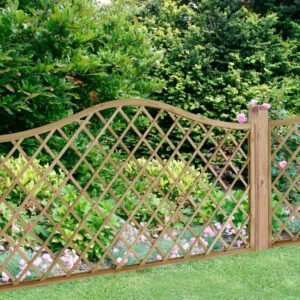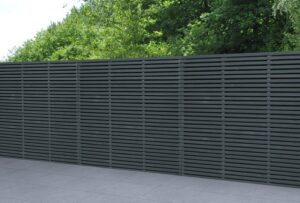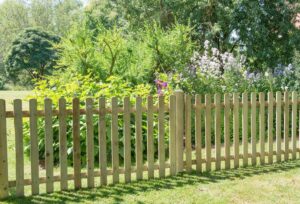If you’re looking to do a substantial garden renovation project, you should seriously consider replacing your fencing first.
Among other things, sturdy new garden fences improve the security of your property and make for lovely décor enhancement.
After all, there’s no point in investing in expensive garden furniture only to see it stolen by opportunistic burglars, right?
The thing is:
When looking to buy new garden fencing, size is of the essence. That’s why at Drainage Superstore, we’ve put together your essential size guide to garden fencing.
Let’s take a deep dive into standard fence panel size and fence post size options and much more.
Table of contents:
- What is the standard panel size?
- What size fence post do I need?
- How do you calculate the size of a fence?
- Choosing the right size fencing for your garden
What is the standard panel size?

Let’s start with the relatively easy bit – how wide is a fence panel?
In the UK, the standard width of a fence panel is 6ft/1.83m. That makes estimating the total number of panels you’re going to need to complete your project fairly straightforward. But more on that later because we’re not finished discussing the size of a standard fence panel.
Here’s the deal:
Unlike fence width, fence heights are available in several standardised options – 3ft/0.91m, 4ft/1.22m, 5ft/1.52m and 6ft/1.83.
So, how do you decide which one to go for?
First things first. As with other aspects of your property, fencing heights are subject to specific building regulations. The most important thing you need to consider is where you’re going to be installing your shiny new fence.
Check this out:
If you intend to fit a front garden fence higher than 3.28ft/1m which faces a public road or footpath, you’ll need to apply for a planning permit. That’s why most homeowners tend to go with the 3ft option, as it requires the least amount of hassle and keeps their view to the outdoors open.
The same rule applies to any side fencing adjacent to a public road – you’re fine with anything up to 1m. Anything higher than that requires a planning permit. Besides, you might also get into trouble with your neighbours, and nobody wants that.
When it comes to back garden fencing, however, you have considerably more leeway. So, you won’t need a permit for a fence all the way up to 6.5ft/2m in height.
This means you can even extend the height and improve the structural integrity of your 6×6 fence panels with a gravel board or a fence topper. Both are popular choices with homeowners, so they’re well worth considering.
In general, 5ft and 6ft fences provide the most security and privacy to your back garden. Having said that, the height you opt for will ultimately depend on your personal preferences and requirements as well as your budget.
To summarise, the standard fence panel size options in the UK are as follows:
| Width | Height | |
|---|---|---|
| Option 1 | 6ft/1.83m | 3ft/0.91m |
| Option 2 | 6ft/1.83m | 4ft/1.22m |
| Option 3 | 6ft/1.83m | 5ft/1.52m |
| Option 4 | 6ft/1.83m | 6ft/1.83m |
Now that we’ve taken care of the size of the standard fence panel, it’s time to move on to the next question.
What size fence post do I need?
No fence is complete without fence posts, and no garden fencing size guide is complete without a brief discussion of this issue either.
Now:
Whether you’re using concrete or wooden posts, their height will ultimately depend on the height of the fence panels you’ve chosen. In general, the posts should be approximately 2ft/0.6m higher than the panels.
For instance, if you’ve opted for 4ft panels, the posts should be 6ft in length. Just remember to include any fence toppers and/or gravel boards in your calculations!
And how deep do fence posts need to be?
You’ve probably figured it out by now:
Posts need to be 2 feet or 0.6m deep – exactly the amount by which the post is taller than the fence. What experts refer to as ‘the 2ft rule’ will ensure an equal overall height as well as sufficient structural integrity through excellent fence post depth.
How do you calculate the size of a fence?

Now that you know everything about fence panel sizes and fence post sizes, all you need to do is measure your fencing area.
Here, height plays no part, except for the fact that higher panels are naturally more expensive. But as long as you’re aware of the length of your garden (or of the part you’ll be fencing if you’re not doing the whole circumference), you’re good to go!
Here’s the scoop:
Unless you’re using bespoke panels, simply divide the total length of the area by six. For example, if it’s 42ft, you’re going to need seven panels. In some cases, you’ll have to round out the number since you obviously can’t install half a panel.
But wait! There’s more:
Each panel requires one post, except for the very last one, which needs two to complete the structure. In this case, you’ll need eight posts. At approximately 3″ for 3ft-4ft panels or 4″ for 5ft and 6ft each, this adds up to another 24″-32″ that you’ll need to enter into the equation.
If in doubt, you should always check with the manufacturer to verify all product measurements.
Choosing the right size fencing for your garden

A new fence is a shrewd long-term investment that’s going to last for at least 10-15 years when properly maintained.
It will benefit your property immensely by raising its value and making your garden a more pleasant, private and secure area.
However, buying and fitting a new fence is also an expensive project. That’s why it’s absolutely crucial to choose not just the right style but also the right size of fencing for your garden.
This way, you’ll save yourself a massive headache and additional expenses later on when you get to putting up and painting the fence.
The good news is:
As long as you keep our size guide to garden fencing handy, you’ll never get stuck when it comes to the standard fence panel size or appropriate post size.














